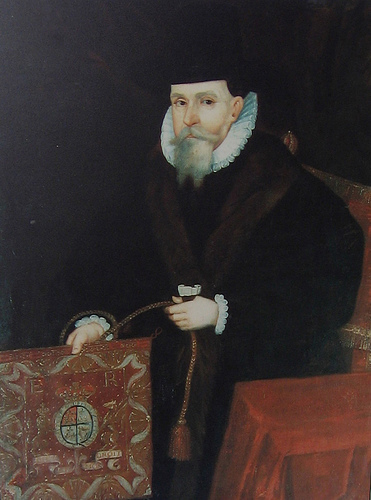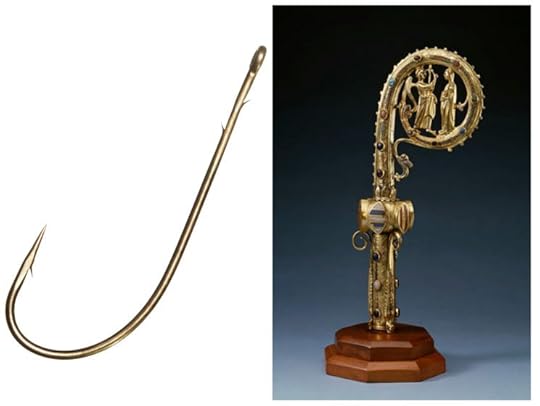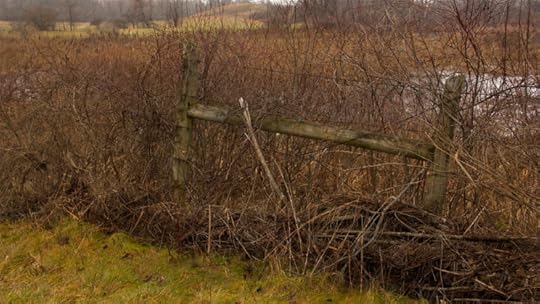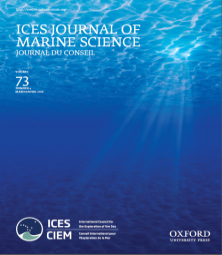Oxford University Press's Blog, page 506
May 26, 2016
How well do you know Thomas Hobbes? [quiz]
This May, the OUP Philosophy team honors Thomas Hobbes (April 5, 1588 – December 4, 1679) as their Philosopher of the Month. Hobbes is remembered as the author of one of the greatest of books on political philosophy ever written, Leviathan, in which he argued with a precision reached by few other thinkers.
But how much do you know about this famous political philosopher? Test your knowledge of Hobbes with the quiz below.
Quiz image credit: portrait of Thomas Hobbes by John Michael Wright. Public domain via Wikimedia Commons.
Featured image credit: The Destruction of Leviathan by Gustave Doré. Public domain via Wikimedia Commons.
The post How well do you know Thomas Hobbes? [quiz] appeared first on OUPblog.

Caring about human rights: the case of ISIS and Yazidi women
Mass sexual violence against women and girls is a constant in human history. One of these atrocities erupted in August 2014 in ISIS-occupied territory and persists to this day.
Mainly targeting women and girls from the Yazidi religious minority, ISIS officially reinstituted sexual slavery. Publicly promulgated, purportedly Sharia sanctioned rules govern buying, selling, gifting, and emancipating abducted women and girls.
Accessing the perspectives of the victims is necessary to understand this flagrant human rights abuse and to secure commitment to restoring their rights.
The victims’ stories that the media and NGOs transmit provide ample information about where ISIS imprisoned Yazidi women and girls, how ISIS transported them, and how ISIS allocated them to men. Documenting these logistics could prove invaluable if it becomes possible to prosecute ISIS leaders and other perpetrators for war crimes and crimes against humanity.
The victims also testify to the workings of ISIS’s sexual slavery system and the suffering it inflicts:
Enslavement:
“They wrote our names on papers around our necks, and sold us.”
“One person bought me and brought me to a prison in Raqqa. One day they called me to be sold again.”
“My captor was killed in a fight, so I was sold again, and then again, but this time I was given as a present.”
Sexual Assault:
“I remember one of the saddest moments there … was this little girl, twelve years old. They raped her with no mercy.”
“I was raped, so many times, even six times per night. They always fastened my legs and arms when they raped me.”
“We were held in a house during the day, then different men would come and pick us up for the night.”
“I kept telling him it hurts – please stop … He told me that according to Islam he is allowed to rape an unbeliever. He said by raping me, he is drawing closer to God.”
 Nadia Murad Basee Taha, a 21-year-old Iraqi woman of the Yazidi faith and a victim of abduction and torture by the terrorist group Islamic State, during the Security Council meeting on human trafficking in situations of conflict. UN photo by Rick Bajornas, used with permission.
Nadia Murad Basee Taha, a 21-year-old Iraqi woman of the Yazidi faith and a victim of abduction and torture by the terrorist group Islamic State, during the Security Council meeting on human trafficking in situations of conflict. UN photo by Rick Bajornas, used with permission.Forced Religious Conversion:
“[H]e wanted to ‘purify’ me from being Yazidi, and forced me to give up my rings, my clothes and all those things that recalled my religion, my identity.”
“They gathered us all in one place and made us repeat after [the leader] … We didn’t dare not say the shahada [the Islamic creed].”
“We were forced to read the Quran and we started to pray slowly. We started to behave like actors.”
Each set of quotations attests to the violation of a human right – the right not to be trafficked, the right not to be tortured, the right to freedom of religion. Provided that journalists and other researchers obtain victims’ informed consent and avoid interview procedures likely to revictimize them, they perform an inestimable public service exposing this human rights cataclysm.
Still, we must ask how disseminating this testimony can strengthen commitment to human rights. Here, empathy is crucial, and empathizing requires viscerally imagining a unique individual and her suffering from her point of view. The human meanings of human rights abuse are manifold. Victims’ stories that go beyond stating the facts of abusive treatment – stories that plumb the subjectivity of enduring and surviving abuse and that situate individual victims in their social and cultural contexts – help us grasp those complex meanings.
So far, the publicly available stories of Yazidi women who have escaped from ISIS are thin. Even so, different victims tell of responding in strikingly different ways.
This woman became bold:
“I was in Mosul when I decided that it was enough. I was scared, but I wore a black abaya and went in the streets. I got on a taxi, told the taxi driver I was escaping from slavery and begged him to help me … He called my brother and asked to arrange a smuggler. My brother knew a driver in Mosul … and asked him to bring me to Badush where he would collect me.”
Another woman despaired:
“One day we were given clothes that looked like dance costumes and were told to bathe and wear those clothes. Jilan killed herself in the bathroom. She cut her wrists and hanged herself. She was very beautiful.”
It might seem counterintuitive that commitment to human rights rests on imagining distinctive individual experiences of abuse. Yet, we don’t really get what’s so bad about abrogating human rights if we haven’t registered that it prompts derring-do in one person, hopelessness in another, and countless nuanced alternatives. The variations in human suffering constitute the poignancy of human rights abuse because they are the shadow side of the dazzling individuality that respect for human rights promotes and protects.
It’s not the attack on an abstraction called humanity or an undifferentiated mass of people that galls us. It’s channeling profoundly personal experiences of degradation, horror, and loss that consolidates moral commitment to human rights.
Featured image credit: Weapon collections, © adekvat, via iStock Photo.
The post Caring about human rights: the case of ISIS and Yazidi women appeared first on OUPblog.

May 25, 2016
By hook or by crook
Here is a phrase whose origin seems to be known, but, as this does not mean that everybody knows it, a short discussion may not be out of place. I have such a huge database of idioms that once in six weeks or so I am seized with a desire to share my treasures with the public. Since open-handedness is a lesser sin than cupidity, I hope to be forgiven.
There was a man called John Bellenden Ker, a noted botanist (the mountain in Australia is named after him), who also wrote A Book on the Archaeology of Our Popular Phrases and Nursey Rhymes, a kind of dictionary in two volumes (1837, 1840). Of all the crazy works on English etymology it is probably the craziest. For some reason, Ker decided that several hundred popular phrases originated in “Low Saxon,” the progenitor of Modern Dutch. Judging by his explanations, he did not have the faintest idea of Dutch. His Archaeology reads like the famous English As She Is Spoke. Few people remember Ker’s book today—the more reason to mention this bizarre composition and warn the unwary. Ker explained by hook or by crook as going back to by hucke o’er krooke; “or, as we now say, by bowing and scraping, by crouching and cringing.” It would be unmerciful to discuss this nonsense further.
Most other conjectures are also wrong but remain within the bounds of normalcy. One can read in many books that at some time in the past two closely associated people existed, one named Hook(e) and the other Crook(e). I have often tried to discover the source of this legend (that is, have there ever lived such counterparts of Messers. Tweedledum and Tweedledee?) but failed to uncover it. Anyway, Hooke and Crooke, we are told, were the judges who in their day decided most unconscientiously whenever the interests of the crown were affected, and it used to be said that the king could get anything by Hooke or by Crooke. According to a more clement version, the two judges were famous for the perpetual diversity of opinion, so that every suitor was sure to have either Hook or Crook on his side. No indication is ever given to the time when those two worthies abused or exercised their power. Presumably, the meaning of the word crook “swindler” gave rise to the first etymology.
The other pair of gentlemen responsible for the emergence of the English idiom has been traced to the great fire of London (1666). Allegedly, when the rubbish left by the fire was removed, the disputes of those whose houses had been destroyed delayed the rebuilding of the city. So two surveyors were appointed to determine the rights of the various claimants, and (what a wonderful coincidence!) not only were they called Mr. Hook and Mr. Crook, but, unlike the two perfidious or contentious judges mentioned above, they turned out to be the very embodiment of integrity. They gave general satisfaction to the interested parties; hence the saying. The person who told this anecdote stated (in 1851) that he had heard if from an old gentleman “upwards of eighty, by no means of an imaginative temperament.” Many of our readers will remember the Grimms’ tale “The Hare and the Hedgehog” about how the slow but smart hedgehog outstripped the fast but arrogant hare. It begins so: “This story was actually made up, young ones, but it really is true, for my grandfather, who told it to me, always said whenever he told it, ‘it must be true, my son, otherwise it could not be told’.” Such is all oral tradition. I may add that most hypotheses depending on the existence of proper names as etymons are fanciful.
The often repeated explanation connects the idiom with the 1172 invasion of Ireland by the English. It resolves itself into the following. Hook and Crook are well-known historic places in the port of Waterford, and the pilots of the invading fleet are said to have declared that they would safely land the invading forces by Hook or by Crook. This legend is (or was) popular in Waterford and Wexford. Surely, reference to real places carries more conviction than a fib about two judges or two surveyors, but it still belongs with countless etiological legends, purporting to explain natural phenomena or historical events by tying them to certain localities. Who heard those pilots? The tale was evidently first told by Adam Loftus, Archbishop of Armagh, in the seventeenth century.
 Archbishop Loftus, Public Domain via Wikimedia Commons.
Archbishop Loftus, Public Domain via Wikimedia Commons.I have also run into the following specimens of intelligent guessing: 1) the idiom probably means “‘foully like a thief or holily like a bishop’, the hook being used by burglars, the crook being the bishop’s crozier”; 2) “an old London legend tells us that the numerous families of Hook and Crook formerly did the ferry business for the whole of the British metropolis. No odds on what boat you crossed the Thames, you were sure to ride with Hook or Crook” (no reference to the source of “an old London legend” is given).
 Hooks are hooked, and croziers are crooked, but this is not why we say by hook or by crook.
Hooks are hooked, and croziers are crooked, but this is not why we say by hook or by crook.The English idiom surfaced in texts at the end of the fourteenth century, a fact that makes some of the hypotheses mentioned above (for instance, reference to the invasion and the fire of London) devoid of even minimal interest. The appearance of a word or set phrase in a book means that it was current and understood earlier, but the time gap does not have to be huge in all cases. The most probable origin of our idiom was discovered as far back as 1850 (such at least is my earliest reference). Medieval conveyancers (that is, lawyers who specialized in the legal aspects of buying and selling property) had to give grant of dead wood for fuel, over a tract of woodland, which might be available without interfering with the more substantial use and profits of the timber for the general purposes of the landowner. The use of axes, bills, or saws was not allowed, while hooked poles, or crooks, by which dry or dead bits of wood could be detached and pulled down from the upper branches of the tree were fine.
 This thicket is full of hooks and crooks.
This thicket is full of hooks and crooks.A few citations in the OED show that hook and crook were at one time interchangeable synonyms. It follows that by hook or by crook is a tautological binomial of the type safe and sound, except that the basis of safe and sound is alliteration, while by hook or by crook depends on rhyme. The OED prefers not to commit itself to any hypothesis of origins; it only indicates that some conjectures are at variance with chronology, and indeed we have seen examples of this flaw above. In the present case, reference to forest customs makes sense. In the Middle Ages, the phrase was a legal formula (such mnemonic devices as rhyme and alliteration are common in the oldest laws of all Germanic-speaking nations, for, in the past, laws had to be reproduced from memory). Later it acquired a “mundane” sense, namely “by all available means,” and this is the reason we are no longer aware of its origin.
Few etymologies are final. This rule holds for idioms as well as for words, but I believe that the derivation presented above possesses a rather high degree of probability, the best thing that can happen to an etymology.
Image credits: (1) “Fish hook” by MrX, CC BY-SA 3.0 via Wikimedia Commons (2) “Crozier with the Annunciation” by Walters Art Museum, CC BY-SA 3.0 via Wikimedia Commons (3) “Thicket” by Chris Burke, CC BY 2.0 via Flickr
Featured image: Fish Hook, Public Domain via Pixabay.
The post By hook or by crook appeared first on OUPblog.

A tradition of classical architecture in California
Today, most people associate Southern California with images of palm trees, beaches, swimming pools, and the entertainment industry. If pressed to imagine an earlier era they might come up with “old” Hollywood, the Gold Rush, or even the mission era. But how much of the Golden State can be attributed to the ancient Greeks and Romans? We caught up with Peter Holliday, author of American Arcadia, who gave us a whole new way of understanding the history of Southern California and how it shaped the region we are so familiar with today.
You advocate that classical antiquity played a major role in shaping the image of California. What does this entail?
California’s booster industries produced fantasy images of both the state’s physical environment and cultural landscape through a variety of mythologizing lenses, most famously the romance of the early missions. But Americans actually perceived California as a realm rich with classical significance. Their history conditioned Americans to think in terms of ancient types, how their education and culture reinforced such thinking. American Arcadia explores how Californians – as boosters and promoters, architects and artists, patrons and clients – engaged with classical antiquity. It investigates how classical antiquity – understood to encompass the civilizations of ancient Greece and Rome – provided another important metaphor for fashioning the Golden State.
Your subtitle refers to a “classical tradition”. What does that mean?
By referring to the classical tradition, I emphasize the sense of continuity among certain forms and themes, conventions that provided components for composition and performance. This construct stresses how groups and individuals deployed the cultural memory of classical antiquity to communicate universal patterns that would be understood by their contemporaries. Unfortunately, today the term “tradition” is loaded for some readers, and conveys connotations of conservatism and elitism. Therefore I underscore the diverse ways in which Californians interacted with the antiquity: for some imitation was paramount, whereas for others innovation suggested new ways of connecting with the ancient past. Californians were not merely passive recipients of a grand past; rather they were active participants in a process shaped by many centuries of earlier encounters. Their action was not simply one of appropriation, either, for the process of engagement tended to alter their sensibilities.
You’ve mentioned “boosters” several of times. What were boosters?
Promoters. Southern California was heavily promoted to Americans. Boosters sold the possibility of an arcadian place to successive groups of settlers, beginning with farmers, then health-seekers, and finally tourists, who might well decide to purchase land and settle. Promotion helped the nascent film industry locate to Southern California, and in turn the movies promoted the region and its promise. The deployment of classical antiquity in framing these promotions to successive target audiences was crucial to their success.
Architecture seems to play a significant role in your book.
That’s because architecture frames the essence of a place. Since it can give focus, order, and meaning to how we experience a location, architecture plays an outsize role in creating civic and regional identity.
 “Chicago Day” at the Grand Court of the Administration Building on the 22nd anniversary of the Chicago Fire (October 9, 1893), Chicago World’s Fair Columbian Exposition. Photo by C.D. Arnold. Public domain via Wikimedia Commons.
“Chicago Day” at the Grand Court of the Administration Building on the 22nd anniversary of the Chicago Fire (October 9, 1893), Chicago World’s Fair Columbian Exposition. Photo by C.D. Arnold. Public domain via Wikimedia Commons.The 1893 World’s Columbian Exposition in Chicago profoundly influenced the form and appearance of Southern California development by inspiring some municipalities to adopt the principles of the City Beautiful Movement, whereas other towns attempted to create a new kind of suburban community that would allow residents to preserve some sense of a pastoral setting. The Beaux-Arts style of architecture encouraged governments, civic institutions, and commercial entities to deploy the style’s classical vocabulary to fashion their images. These impulses also influenced domestic architecture before WWII. The styles in which Californians built their houses, designed their gardens, and decorated their interiors were diverse and eclectic, but frequently drew inspiration from some aspect of the ancient world.
In the last century it was common to deride the domestic architecture in Los Angeles for being ersatz, akin to a series of stage sets, yet you find positive things to say about the use of historical or period styles in such building.
In his great Hollywood novel, Day of the Locust (1939), Nathanael West’s Yale-educated protagonist, Todd Hackett, embodies the progressive understanding of architectural thought of the day. He sees Southern California’s mishmash of architectural styles as a violation of Modernism’s teachings on the virtues of organic form and truth to materials; he finds the houses vulgar and flimsy, much like the culture that built them. “When he noticed that they were all of plaster, lath and paper, he was charitable and blamed their shape on the materials used,” West writes. “Steel, stone and brick curb a builder’s fancy a little, forcing him to distribute his stresses and weights and to keep his corners plumb, but plaster and paper know no law, not even that of gravity.” West thereby disparages Southern Californian eclecticism as also representing “inauthentic” construction techniques and materials.
Well, there is some truth to the shoddiness of the region’s “back-lot” construction practices, isn’t there?
Several years ago I took a colleague from New York on an architectural tour of Los Angeles. We ended the day with drinks at Evan Kleiman’s now-defunct Angeli Caffe, whose façade and interior had been designed by Morphosis in 1984, at that time a very trendy statement. Watching construction on a structure across Melrose Boulevard, my friend was taken aback at the use of plywood (!) to reinforce the wood framing on the first of three floors. He protested that such shabby construction would never be permitted under the codes of New York City. I offered how the traditional lessons learned in childhood do not necessarily hold in earthquake country, where I would much prefer to ride out a temblor in a house crafted from lighter and more flexible straw or sticks rather than being crushed beneath the collapse of one made of bricks. Of course, careful design and skillful execution matter. Southern Californians shared many outlooks with the rest of America, but also expressed attitudes and followed practices distinctive to the region.
 Image credit: Hollywood Sign photo by Sörn. CC BY-SA 2.0 via Wikimedia Commons.
Image credit: Hollywood Sign photo by Sörn. CC BY-SA 2.0 via Wikimedia Commons.You cite Day of the Locust as a “Hollywood novel.” How has the entertainment industry, centered in Southern California, helped shape American tastes?
In the last century, the movie industry, thanks to the studio publicity machines, exercised an outsized influence on American preferences in domestic architecture and garden design. It was not simply the images projected in theaters. The 20th century also saw the rise of life-style magazines; features on the stars at home were prominent. In the postwar era, television shows – notably produced in Los Angeles – presented Americans with a suburban ideal as realized in Southern California. Although many programs were set in generic suburban enclaves with generic names like Springfield (Father Knows Best), Mayfield (Leave It to Beaver) or Hilldale (The Donna Reed Show), some featured more identifiable California locales. Of necessity, Gidget had to have access to the surf at Malibu, and her widowed father was made an English professor at UCLA; Fred MacMurray’s widowed father in My Three Sons was an engineer in the region’s important aerospace industry; and in the 1970s, the father of The Brady Bunch was an architect who designed his own house in the San Fernando Valley. Television families engaged in recreational activities out-of-doors, with sons shooting hoops in the driveway and scenes taking place on patios and at the barbecue as well as in living rooms and around the kitchen table. The Golden State advertised its postwar middle-class good life to a national audience.
That simply sounds like the postwar American dream. Did classical antiquity play a role in those images?
Absolutely. Consider how the Southland’s sunny climate, first promoted by the region’s boosters, actually encouraged Californians to lead their lives differently. Self-consciously emulating ancient Greeks and Romans, Southern Californians initiated trends that would change the way Americans eat, dress, and spend their leisure time. Californians even fashioned their bodies according to classical ideals. Visual artists were sensitive to this new conception of beauty, and represented it in various media throughout the 20th century.
Much of your discussion focuses on Los Angeles, but you sometimes seem to stray outside the confines of Southern California.
Although my primary focus is on Los Angeles, early promoters and real estate speculators made no distinction between “Southern California” and “Los Angeles,” so I feel quite comfortable looking as far north as San Simeon and southwards to San Diego. On occasion I consider what was happening in San Francisco to cast light on Southland projects, for at one time that city was the dominant political and economic power in the state, and thus set the pace in the arts; at one point I even cross the state border into Nevada, since Las Vegas was largely developed as an entertainment suburb of Los Angeles. American Arcadia considers Southern California in the context of American culture as a whole at any particular moment. It provides a new way of seeing ourselves and our past, through a language that was familiar – for a time even central – to our predecessors, that will not only help explain some of the monuments they left behind, but also how we got to where we are today.
Featured image credit: The Getty Villa — in Pacific Palisades, Los Angeles. Photo by Bobak Ha’Eri. CC BY-SA 3.0 via Wikimedia Commons.
The post A tradition of classical architecture in California appeared first on OUPblog.

An elusive quest for a recipe for success in economic development
For some decades before the turn of the Millennium, the growth prospects for most of the developing world looked extremely bleak. Income growth was negligible and poverty rates were high and seemed stubbornly persistent. Some even suggested that the barriers against development were almost insurmountable as progress in the already rich world was argued to come about at the expense of the poor. Then in the late 1990s, global economic dynamics changed and the future of the world’s poor seemed brighter.
Africa started to rise from the doldrums, and giant economies, particularly in Asia but also in Latin America, began to challenge the world order as dominated by the industrialized North. Heavyweight commentators such as The Economist and Time Magazine, reporting on the state and trend of the international economy, noted that the South was witnessing a new dawn. The message was that poor countries will catch up because they will always have the advantage that income-generating technologies are readily available and that poor country labour costs are typically lower. If trade is open and macroeconomic and governance fundamentals are sound, then little stands in the way of this advantage being realized. Critics maintain, however, that even if income growth in poor parts of the world occasionally happens, the long-term trend is still depressing as the absolute gap between rich and poor continue to increase. Poor countries cannot catch up. In a sense both understandings might be justified, as we have seen poor countries catching up also in the past, but it has rarely been sustained. The question becomes what to believe, and how to grasp if there are deeper dynamics at play?
In the discussion on how economic development can be achieved, metaphors relating to familiar and easily comprehended situations are sometimes used to structure the thinking about complex processes. One such analogy is to see development as if it were baking. For success you’ll need the right ingredients, adequate tools, and a recipe. Much of the development reason have been following these lines. For example, a country needs capital to develop. If there is not enough available in the country, it can simply be added from outside through, for example, aid. But we also know that you cannot just throw all items in a bowl, stir, and hope for the best. The recipe gives codified instructions of proportions, efforts, and sequence. Bakers of all kinds know that the end product seldom looks the same, and definitely not as good as the picture in the cookbook or on the Great British Bake Off. To succeed you need baking capabilities. Experience counts. Still, success is far from guaranteed. What works in one setting does not necessarily work in another.
When baking, different ovens might bake differently, and when developing, different contexts might yield different results. We know that the ability to adjust to both internal and external conditions is highly important. Variation matters. The options are then getting greater, but the drawing of workable lessons is getting thornier. And to make matters even more complicated: what if capabilities are lacking or some ingredients deemed necessary are missing altogether? Maybe the recipe becomes misinterpreted, misleading, or even counterproductive? After all, the lack of some prerequisites might be the fundamental reason why poor countries are poor in the first place.
So, while we certainly know some things about the development process, we are painfully aware of the fact that a universal recipe does not exist. A recipe might still be useful but only to a certain extent. What should a poor country do?
Even if growth locomotives such as China and Brazil show signs of losing steam, possibly affecting other countries adversely, long-term history is not only doom and gloom. Although examples are few, some poor countries have been able to close the development gap, and hundreds of millions of people have been able to escape dire poverty. Arguably, turning to history to gain insight on how development obstacles have been overcome is a potentially feasible approach when facing the question of how to sustain growth in living standards and a reduction in poverty for the least fortunate countries. But the use of history should be inspiring rather than a straight jacket. There is strong empirical support that structural transformation, for instance, the relative decline in the importance of the agricultural sector, is a necessary feature for a sustained rise in human wellbeing. But this might not be sufficient for the development process to gain strength.
To get on with it requires a recipe and a baker that is sensitive to the characteristics and initial conditions of the country destined to catch up. Given the potential gains, to disentangle both the fundamental and particular ingredients needed for success in economic development is a worthwhile endeavour.
Headline image credit: View from the Peak by Shepard4711. CC-BY-SA-2.0 via Flickr.
The post An elusive quest for a recipe for success in economic development appeared first on OUPblog.

On the finiteness of the atmosphere
I guess the funniest thing I ever saw was a person driving down the highway in a Toyota Prius smoking a cigarette with the windows closed. It was like they were telling me, “I respect your atmosphere but not mine.” That got me thinking, does human generated, gaseous, atmospheric pollution actually make up a significant part of the total atmosphere, and can it possibly affect it? In other words, is this merely a very delicate series of calculations one must carry out to see that the atmosphere, and us, can be affected by gaseous pollution?
So, what I set out to do was determine how much pollution is generated and compare that to the volume of the atmosphere. The first aspect is easy. There are numerous sources of data on the amount of carbon dioxide (CO2) and other chemicals generated on Earth every year. We know how much power is used by all the societies on Earth and that burning fossil fuels generates a given amount of pollution, so, we can determine there is about 33,000,000,000,000 kg of CO2 produced each and every year. That is 33 with twelve zeros after it or 3.3 × 1013 kg-CO2.
This is a big number by any measure. How big is it compared to the atmosphere? The Earth is huge, as is the atmosphere, so how can even such a large amount of CO2 even compare to the size of the atmosphere?
The atmosphere is most dense at the surface and gradually decreases in density (or equivalently pressure) until it fades to nothingness. This doesn’t help much.
To find out how much atmosphere there is one must remember the definition of pressure. If I were to step on your foot with my flat soled shoe it may hurt, however, if I were to step on your foot while wearing a high heel it would certainly hurt. (I don’t have a pair of high heels, this is merely a visual metaphor…) The difference is pressure, force per unit area.
I have the same amount of mass, it’s just that I concentrate it on a smaller area when wearing high heels and the pressure is greater. I know the pressure of the atmosphere and I know the area of the Earth’s surface, so, I can easily calculate the mass of the atmosphere. It is actually 5,200,000,000,000,000,000 kg (5.2 × 1018 kg)!
The amount of atmospheric CO2 is actually measured in parts per million or ppm, in fact its ppm measured on a molar basis which is a way to compare the number of CO2 atoms to the number of atmospheric atoms. I can convert kg’s to mole’s to find that my calculation gives 4.2 ppm. This is the amount of CO2 generated every year and adds to the previous year’s total concentration since CO2 has a very long lifetime.
This can be compared to how much CO2 is in the atmosphere right now. It has been measured at the Mauna Loa volcano in Hawai’i since the late 1950s, where it was a little under 320 ppm, to now where it is approximately 400 ppm. Recently, the rise in CO2 has been about 1.7 ppm per year.
The annual emission of CO2 is 4.2 ppm, and the data shows there is a 1.7 ppm annual increase, why the difference? Firstly, it’s important the numbers are about the same validating the above estimate. Secondly, it is known the oceans acidify when CO2 is absorbed by water to make carbonic acid and accounts for some of annual reduction of CO2 in the atmosphere. Some is also absorbed by the land and trees.
One cannot deny the CO2 concentration increase is due to human activity. The atmosphere is truly finite in size despite its perceived largeness from one’s isolated view.
Featured image credit: The atmosphere outside my apartment building by Michael E. Mackay. Used with permission.
The post On the finiteness of the atmosphere appeared first on OUPblog.

May 24, 2016
Spiritual awakening in Alcoholics Anonymous
Alcoholics Anonymous has provided millions of people with a chance at recovery from addiction. There is one aspect of membership for some members that most people, even addiction specialists, are not aware of, namely, the remarkable transformation that many AA members call a spiritual awakening. It’s a remarkable phenomenon for anyone interested in social science on the addictions.
AA has twelve “Steps” that members are encouraged to follow. After completing the first eleven of these Steps, they are ready for the last one, which begins with the phrase “Having had a spiritual awakening…” This is not cited casually. It hearkens back to a seminal moment in the genesis of the fellowship, the experience of AA’s co-founder, William Wilson. In December 1934, Bill W, as he is referred to in AA, was admitted to the Towns Hospital in Manhattan for a fourth episode of drying out. He was despairing of hope at that point, but later wrote of a transformative experience he had while there: “It seemed to me, in my mind’s eye, that I was on a mountain and that a wind not of air but of spirit was blowing.”
This was a “spiritual awakening” for Bill, dramatic in quality, and one that would serve as a model for future AA members seeking redemption from their addiction. Even today, generations later, there remains an expectation of transformation that serves as a turning point in many long-term members’ own recovery.
At the NYU School of Medicine, we had framed a survey to measure the impact of spiritual awakening on AA members’ addictions. We asked participants to rate the degree of craving for alcohol or drugs they had experienced in the previous week. Later in the survey, they were asked to indicate whether or not they had experienced a spiritual awakening. We surveyed attendees at a conference of doctors in AA, most with long-term sobriety, and most participants reported having had a spiritual awakening. The majority who reported affirmatively on this were twice as likely to have experienced no craving at all in the week that they filled out our survey as those who had no such experience. If you think about it, addicted people coming to experience no craving at all is remarkable, since alcohol and drug addiction are characterized by the craving that drives people to relapse.
 According to recent studies, experiencing a spiritual awakening will decrease the likelihood of substance cravings. Image Credit: Wine glasses by jackmac34. CC0 public domain via Pixabay.
According to recent studies, experiencing a spiritual awakening will decrease the likelihood of substance cravings. Image Credit: Wine glasses by jackmac34. CC0 public domain via Pixabay.An awakening can be very dramatic in character, as one doctor described:
I was there in rehab with 50 bucks hidden in my sock. I wanted to get out and get on a subway and come home.
I went outside the building and was having a cigarette, when all of a sudden a sense of peace came over me and I didn’t see it, but I felt the presence of a person, and in my mind that person was Jesus. It was strange. I was sort of embarrassed. I felt his presence, and then a peace for no more than three or four minutes. This seemed to be part of a message. I was set to come in from the cold. And then I listened and let these people help me. I realized that it was not about judging, it was about acceptance.
On the other hand, for most members, a spiritual awakening is neither sudden nor dramatic, and can be an ongoing and continuing process, but no less meaningful than if experienced with great drama. Here is one example of how the more gradual process of spiritual experience was described:
One day I was walking along the beach in Nantucket and it was 5:00 PM, and I realized that I didn’t have the compulsion to run home and have a drink, and it was a great relief. I go to AA every morning at 6:30 AM and see the sunrise, so every morning I have a spiritual experience. That’s my spiritual experience. They’re not big epiphanies but, along the way, little ‘ephiphanets.’
We wanted to see if we could develop a systematic understanding of the experiences that people affixed to their awakenings: For whom did these come about in a sudden manner, and for whom did they emerge more gradually, over time? Was it common for people to have a sensory experience, as in the first example here? Did they take place in the midst of adversity, as in the depths of drinking?
To answer questions like these, we again turned to the doctors’ group of longtime AA members. The majority reported that it had come about gradually rather than suddenly, and took place while they were working the Steps rather than before or afterwards. The majority reported that they had felt craving for alcohol the week before their awakening, whereas only half that number felt that in the week thereafter. Almost half of the respondents had been using alcohol or drugs during the previous week, whereas the use went down to only one in ten in the week thereafter. Since awakenings presumably put people closer to the AA fellowship’s spiritual orientation, we wanted to know how this might be measured. The majority of those who had an awakening reported that they now felt God’s presence in their lives on a daily basis, but only one in eight of those who had not experienced an awakening felt it that often.
Altogether, we documented a diverse group of experiences, ones that did indeed bolster the doctors’ commitment to AA. In many respects, however, it is the uniqueness of such experiences that is most compelling. The awakenings are personal, and illustrate the individuality of respective members. They go a long way in helping to explain how some people get sober in the AA fellowship.
Featured image credit: Sunrise by The US Army. CC BY 2.0 via Flickr.
The post Spiritual awakening in Alcoholics Anonymous appeared first on OUPblog.

A tap dance quiz for National Tap Dance Day
25 May is National Tap Dance Day, commemorating tap dance, our earliest American vernacular dance form and a national treasure. My tap teacher Charles “Cookie” Cook, the famed member of the Copasetics Club, used to say that if you can walk (or even snap your fingers or toes to the rhythm), you can (tap) dance, thus making all of us tap dancers. But how how many notable tap dancers can you name? This quiz is but an introduction to the dozens of dancers who forwarded the form and helped to popularize tap dance.
Featured image credit: Dance by Amanda Slater. CC-BY-SA-2.0 via Flickr.
The post A tap dance quiz for National Tap Dance Day appeared first on OUPblog.

May 23, 2016
World Turtle Day: a reading list
World Turtle Day is celebrated on 23 May every year since its inception in 2000. The American Tortoise Rescue sponsors this day of awareness to bring attention to one of the world’s oldest reptiles, and encourage humans to help in the conservation and protection of these grand animals. In honour of these grandiose creatures, we have compiled a reading list of biology titles and articles that have helped to further research into the conservation biology of all chelonians.
 A Field Guide to the Reptiles of Thailand, by Tanya Chan-ard, Jarujin Nabhitabhata, and John W. K. Parr
A Field Guide to the Reptiles of Thailand, by Tanya Chan-ard, Jarujin Nabhitabhata, and John W. K. Parr
Examining all the reptiles in Thailand, this book provides details about all the Testudines living in the varying habitats across this diverse country. Physical appearance, geolocation, habitat and climate are discussed for each of the six families present in Thailand, giving readers the tools to spot these creatures in the wild.
Tetrapod Evolution, by Michel Laurin, available on Oxford Bibliographies.
This article brings together a host of resources about the evolution of the four-footed animals, including sections on the phylogenesis of turtles, and the evolutionary history of one of the oldest reptiles.
 “Plastic and marine turtles: a review and call for research” by Sarah E. Nelms, Emily M. Duncan, Annette C. Broderick, Tamara S. Galloway, Matthew H. Godfrey, Mark Hamann, Penelope K. Lindeque, and Brendan J. Godley in ICES Journal of Marine Science.
“Plastic and marine turtles: a review and call for research” by Sarah E. Nelms, Emily M. Duncan, Annette C. Broderick, Tamara S. Galloway, Matthew H. Godfrey, Mark Hamann, Penelope K. Lindeque, and Brendan J. Godley in ICES Journal of Marine Science.
Plastic debris is ubiquitous in the marine environment. This study reviews the evidence of the effects of plastic debris on turtles and their habitats, highlights knowledge gaps, and makes recommendations for future research.
The Ecology, Exploitation and Conservation of River Turtles, by Don Moll and Edward O. Moll.
This book puts the ecology and conservation of river turtles at its focus, attempting to shed light on the decline of these animals in the wild. Recommendations for projects and conservation measures are made in a bid to help future research into these precious testudines.

The New Encyclopedia of Reptiles and Amphibians (2 ed.), edited by Tim Halliday and Kraig Adler, available on Oxford Reference.
Turtles are perhaps the most recognizable backboned animals on the planet. This encyclopaedia entry offers details about every aspect of their being including their physiology, habitats, diet, mating habits, etc. This is your first stop for an introduction to the world’s chelonians.
“Assessment of ground transportation stress in juvenile Kemp’s ridley sea turtles (Lepidochelys kempii)” by Kathleen E. Hunt, Charles J. Innis, Adam E. Kennedy, Kerry L. McNally, Deborah G. Davis, Elizabeth A. Burgess, and Constance Merigo in Conservation Physiology.
Sea turtle rehabilitation centres frequently transport sea turtles for long distances to move animals between centres or to release them at beaches. The authors conducted a study to assess whether transporting Kemp’s ridley sea turtles is stressful for the animals and results in recommendations for handling protocols.
 Experimental Approaches to Conservation Biology, edited by Malcolm Gordon and Soraya Bartol, available on University Press Scholarship Online.
Experimental Approaches to Conservation Biology, edited by Malcolm Gordon and Soraya Bartol, available on University Press Scholarship Online.
The rate of species extinction has almost never been higher. This book addresses the need to better understand and find solutions to the crisis Earth finds itself in, arguing for experimental approaches to conservation biology. Looking at animals living on both land and in the sea, new methods of learning about their ecology and physiology are introduced. Read Chapter 5.
 Reptile Ecology and Conservation, edited by C. Kenneth Dodd, Jr.
Reptile Ecology and Conservation, edited by C. Kenneth Dodd, Jr.
Covering more broadly the topics surrounding the conservation of reptiles in their natural habitats, three essays in this collection examine the practices of sampling turtles for scientific research. Providing best practice guides, methodologies and suggestions on possible outcomes, this book is an informative introduction to greater conservation practices.
The Man Who Saved Sea Turtles, by Frederick R. Davis.
Archie Carr played a leading role in highlighting the importance of natural history and systematics in the twentieth-century scientific arena. For five decades he studied turtles and herpetology to develop theories on ecology and evolution. This book is explores his life and the impact he had on conservation philosophy during the last century. Read Chapter 8.
Tell us your favourite book on turtles, tortoises, and terrapins in the comment section below, and join the discussion on Twitter using hashtag #WorldTurtleDay or check out what’s happening in your area on their Facebook page.
Featured image credit: Many turtles by torange.biz. CC-BY-4.0 via torange.biz.
The post World Turtle Day: a reading list appeared first on OUPblog.

Veepstakes 2016: A Reality Check
Who will Hillary Clinton and Donald Trump–the Democratic and Republican Party’s likely nominees for president, respectively–pick as their vice presidential running mates? Let’s start here: It probably won’t matter much. Or, we should say, it probably won’t matter in terms of deciding the election. It could matter a great deal, however, in terms of what comes after the election. Allow us to explain.
Every four years, journalists and political analysts devote an extraordinary amount of time and attention to speculating about who will (and should, or at least could) win what is commonly known as the “veepstakes”–that is, who will be selected by a major party’s presidential candidate to run alongside him/her in that year’s election and, if elected, to serve as vice president of the United States. The assumption, often implicit, underlying such speculation is this: Running mates can deliver votes from strategically important groups within the electorate–e.g., residents of a key battleground state or an important demographic minority group–and with this change the outcome of the election. The opportunity to alter history through sheer strategic brilliance is an irresistible fantasy for any campaign manager or political junkie, which is what makes the veepstakes so fun to play. But, according to our research, in most cases it amounts to just that: a fantasy.
We have found no evidence of a systematic vice presidential “home state advantage”–that is, voters are no more likely to vote for a party’s presidential ticket when its running mate comes from their home state, generally speaking. However, this advantage does occur under a narrow set of conditions–specifically, when the running mate comes from a relatively less-populous state and has served there as an elected official for many years. If the running mate fails to satisfy both conditions, the ticket will perform no better in the home state than it would without him/her on the ticket.
In contrast, presidential candidates generally earn a statistically significant home state advantage. Why? Because voters typically vote based on the presidential candidate’s characteristics, not the running mate’s. Indeed, presidential and vice presidential candidates prove more popular among home state voters, we find (using American National Election Studies “feeling thermometer” measures rating each on 0-100 scales). But this popularity only translates to votes for presidential candidates.
We found a similar pattern of results when examining the performance of running mates from underrepresented demographic groups, including women (Geraldine Ferraro, 1984; Sarah Palin, 2008) and Catholics (Sargent Shriver, 1972; Ferraro, 1984; Joe Biden, 2008; Paul Ryan, 2012). Voters from the same demographic groups rated these running mates more positively but, once again, proved no more likely to vote for the presidential ticket on which he or she appeared. By contrast, Catholic and African-American voters were significantly more likely to vote for presidential candidates John Kennedy (1960) and Barack Obama (2008), respectively. Again, voters seem to be voting for the presidential candidate, first and foremost.
What does this mean for the presidential candidacies of Hillary Clinton and Donald Trump? Quite simply, it means that voters will be voting for or against Hillary Clinton and Donald Trump, not their running mates.
Let’s let that sink in, by way of example. If Trump picks Florida Senator Marco Rubio as his running mate, Floridians will still be voting based on what they think of Donald Trump, not Marco Rubio. So will Latinos (Rubio is Cuban-American). So will Catholics (Rubio is Catholic). Each group of voters can be expected to like Rubio better than others voters, but they will be no more likely to vote for the Republican ticket than non-Floridians, non-Latinos, and non-Catholics. Rubio will not “deliver” these voters, in veepstakes parlance, like a shepherd in control of his easily-manipulated flock. Voters have minds of their own, and those minds will be focused on evaluating their actual objects of decision, presidential candidates Hillary Clinton and Donald Trump.
So, this means that vice presidential selections don’t matter at all, right? Wrong.
In recent decades, vice presidents have played an increasingly important role in the governing process. While that may not have been the case throughout much of American history–in fact, Franklin D. Roosevelt’s first vice president, John Nance Garner, famously remarked that the office wasn’t “worth a pitcher of warm spit”–modern vice presidents play a key role in moving legislation and shaping executive branch policies. Just consider the substantial influence of our two most recent vice presidents, Dick Cheney and Joe Biden, on weighty policy matters ranging from energy to terrorism to the federal budget. And let’s not overlook the obvious: the vice president could become president in the event of an impeachment, resignation, death, or incapacitation. As John Adams most aptly put it: “I am vice president. In this I am nothing, but I may be everything.”
Vice presidential selections matter a great deal, but not for the reasons usually animating veepstakes speculation. It is very unlikely that a running mate will deliver a home state or a demographic group that will change the outcome of the presidential election. However, it is a modern certainty that the vice president, once in office, will play a significant–albeit largely informal and advisory–role in the governance of the United States. With this in mind, each presidential candidate, and the country for that matter, would be served best by evaluating a vice presidential finalist’s ability to function as an effective partner in running the country. Electoral credentials–what little influence they bear–cease to be relevant on Wednesday, 9 November 2016. Governing credentials, on the other hand, will be relevant for four or eight years to come. This is why, if the presidential candidates are wise, they will follow the empirical evidence (and, one would hope, their conscience) by thinking beyond Election Day when vetting potential running mates.
Featured image: “New Executive Branch” by Steve Jurvetson, CC BY 2.0 via Flickr.
The post Veepstakes 2016: A Reality Check appeared first on OUPblog.

Oxford University Press's Blog
- Oxford University Press's profile
- 238 followers



